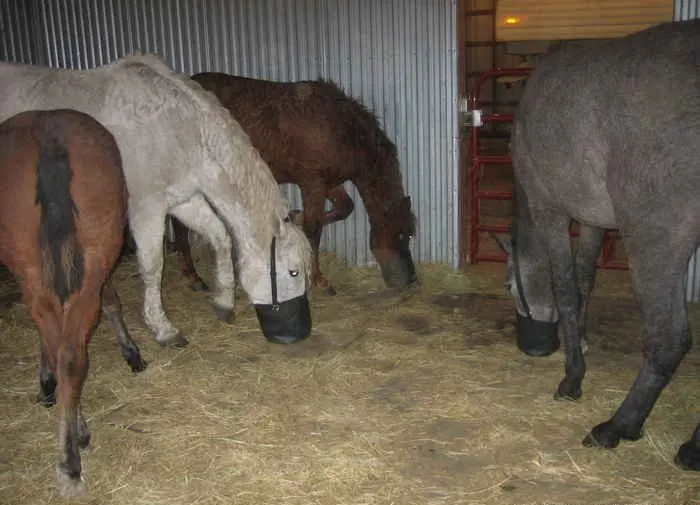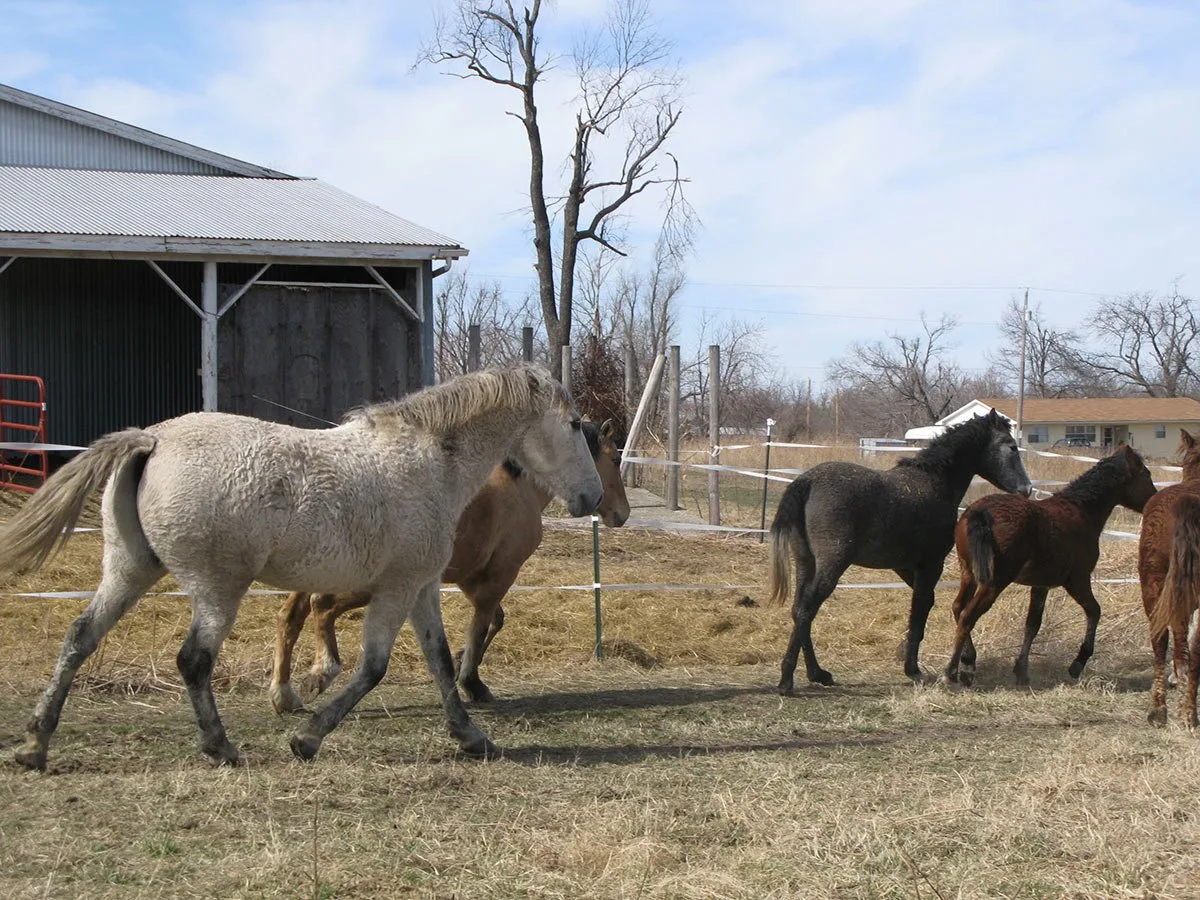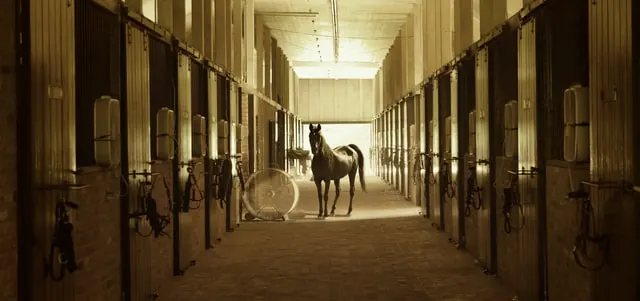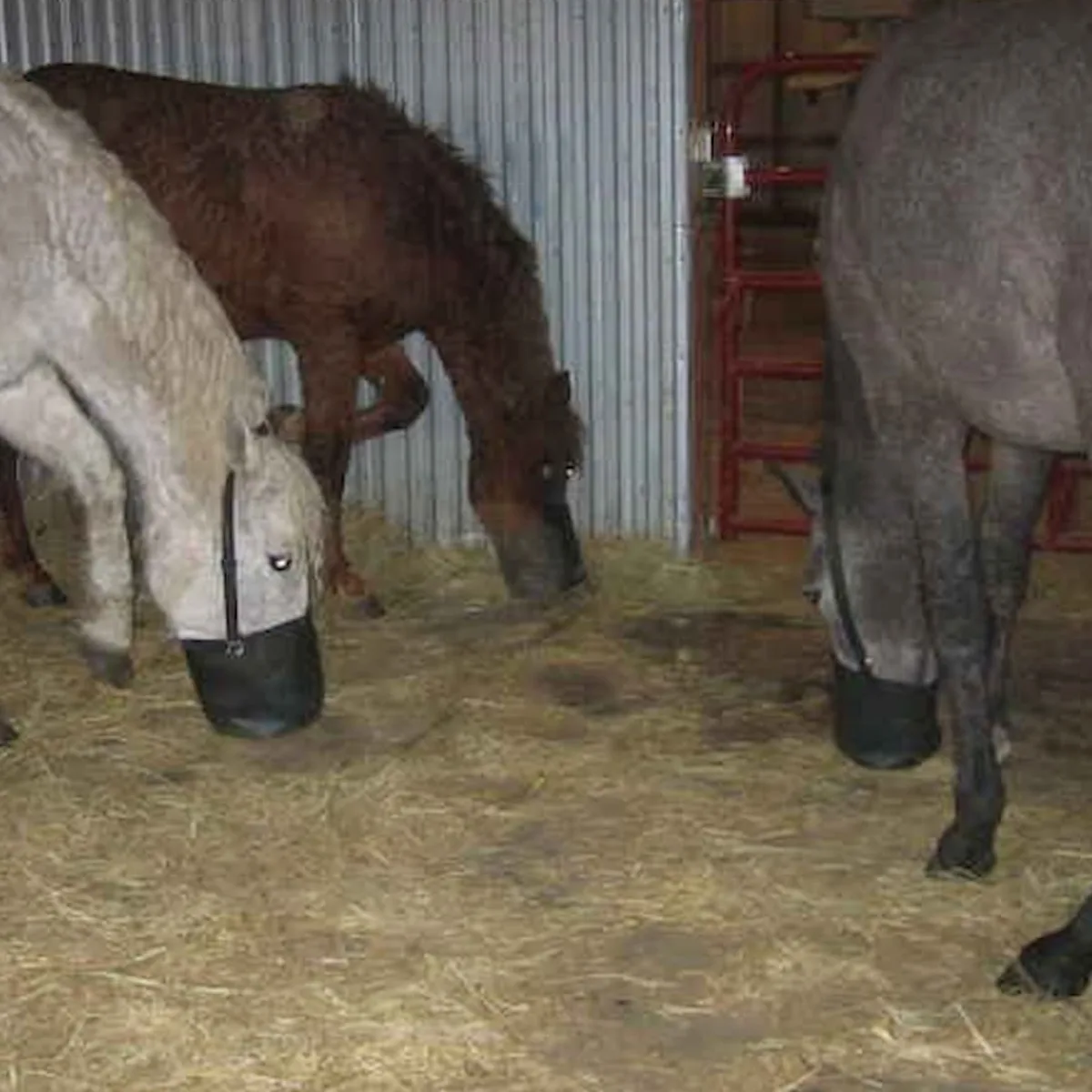I never imagined I’d become an advocate for horse feed bags, but once I tried this old-fashioned method for feeding horses, I was hooked. Read on to learn more about my process of turning to feed bags as a way to save time, effort, and hassle at feeding time on our horse farm.
First, what are Horse Feed Bags?
A feed bag is a small nylon, mesh, or canvas bag that fits over a horse’s muzzle and is used to feed the horse grain or supplements. A feed bag includes a strap that fits over the horse’s head and rests just behind the ears. The bag is typically a few inches wider than the average horse’s muzzle, and is 6 to 10 inches deep to prevent grain from spilling.
Feed bags are an easy way to deliver the proper portion of grain or other horse food to horses that are living in a herd- since feed bags prevent bossy horses from stealing other horse’s food.
Most horse feed bags have a mesh panel or grommet holes to allow the horse to breathe freely while the bag is being worn. Sometimes the adjustable head strap is slipped on over the ears, though often the strap includes a plastic quick-release buckle.
Pros:
- Horses waste less food.
- Horses readily switch to this feeding method.
- Horses eat their food, and only their food.
- No need to separate horses at feed time.
- More consistent method for adding medications and supplements to feed.
Cons:
- They wear out faster than feed pans and buckets.
- Horses should be monitored while using.
- Feed bags must be removed immediately after the horse finishes eating.
- Drinking while eating is limited (and potentally unsafe in non-mesh bags).
How are Feed Bags Used for Horses?
Not all horses are fed using feed bags, in fact, the use of feed bags is pretty rare today. Feed bags were once commonplace pieces of horse equipment that could be found on every farm and ranch in the United States.
Feed bags fell out of favor as methods of horse management modernized to favor indoor stabling for show horses, performance horses, and working horses. As horse-keeping methods have continued to evolve, more and more horse owners are returning to keeping horses outdoors, in herds, and in shared horse stalls.
Often, however, when it comes time to feed horses each day, owners or handlers go through the hassle to separate each horse to their own individual stall or pen for feeding that horse the unique blend of grains, pelleted feeds, and supplements that have been selected to boost that particular horse’s performance and health.
Feed bags solve this problem and simplify feeding time. Instead of separating each individual horse for feeding, with feed bags, the horses can remain together in their herd with no risk that horses will switch buckets or run one another away from their designated feed pan.
Feed bags do require that a human handler stays nearby to remove the bag when the horse has finished eating. Feed bags should not be left on past the point that the horse has finished eating their food.

Our experience converting to using feed bags on our farm
About two years into starting our farm, I began to research the benefits of communal stabling and keeping horses – especially yearling horses and foals – in mixed herds. Keeping horses in herds, research from Michigan State University indicates, decreases anxiety and improves social skills for horses. However, with a diverse variety of nutritional needs among our small herd, it became a challenge to make sure that broodmares got that different feed than yearlings, and foals got different food than the gelding that I trained for horse shows and breed demonstrations.
I first encountered nose bags through a comped gift given to our partner tack store. I’m not sure that I would’ve tried feed bags for my herd on my own, but with a free one to try, I decided that maybe horse grain bags are worth trying- and from the very first feeding time that I tried, I was hooked!
It was so much easier to clip a feed bag over a horse’s head as they dove in for their meal than it was to separate each horse out into separate pens or try and supervise group feedings to prevent horses from switching feed pans.
Within a week, I ordered a bag for every horse and the amount of time and work that went into feed time decreased immediately. With feed bags, I could feed the whole herd together and know that each horse was getting the proper blend of horse feed, supplements, and any medication they needed. Although I did have to special order ones for my yearlings and weanlings – and I purchased a draft horse feed bag for my particularly heavy-headed gelding, it wasn’t difficult to find a bag that fit each horse.
Training my horses to use feed bags
Although many horses are cautious about new tack and equipment, because this retraining involved food, my food motivated Bashkir Curly Horses were easy to convince. Within the space of few feed times, all of the horses adapted to eating out of feed bags.
The first time I used feed bags for my horses, I separated each horse and introduce them to the bag in a quiet space where I wouldn’t have to worry about a more eager horse stomping in and shoving their nose into the feed bag.
For that first feeding, I let the horse eat out of the bag on the ground, without strapping it up over their head. In this way, the horse was able to get used to eating out of a flexible fabric mesh bag, and the unique sensations that came with that switch from eating out of a rubber feed pan.
By the second feeding cycle, my horses were comfortable enough with the feed bags that I used the strap. Apart from a few tail switches, all of the horses were agreeable to the switch and we began feeding them in a group shortly after.
Other names for Feed Bags
Since feed bags fell out of popularity in the 20th century, even horse people have kind of forgotten what the proper name is for these pieces of equipment. Although there sometimes confused with feed sacks, the term “feed bag” can be used interchangeably with the large, heavy sacks that farm supply stores sell horse grain and pelleted feed in. Horse feed bags are also sometimes called nose bags or grain bags.

Using horse feed bags in a herd with alpha horses
Group feeding is always tricky when a herd has an uneven power dynamic (which is a natural dynamic for groups of horses). When I first began using feeding bags I was concerned that my most dominant mare might still attempt to run-off submissive herd members at feed time.
Even though there was no way that she could steal their feed I had some concerns about this being stressful for the horses. Thankfully, this feeding process is sort of a self-training one: it didn’t take too many attempts on the alpha mares part to realize that her efforts to steal other horses feed just didn’t work when feed bags were the feeding method.
Choosing a good feed bag for your horse
As feed bags become popular for horses again, there are more and more options available on the market. Here are a few things to look for when you’re shopping for a feed bag:
- The interior of the nose grain bags should be seamless– with no ridges to catch debris.
- The inside rim should have a small flap or gutter to prevent spills if a horse lifts their head during feeding.
- There should be a large mesh panel or the feed bag should be made entirely of fine mesh (Some only have a few holes which I find to be insufficient).

How to clean horse feed bags
The following section may contain affiliate links. As an Amazon Associate, we earn from qualifying purchases.
Any horse feed bags tough enough to be used with horses should hold up well to being washed in a washing machine.
Before I toss feed bags in my washing machine, however, I soak them in a bucket to loosen and remove the worst of the gunk, dirt, and debris that becomes stuck to the bags. After a brief soak, I place my feed bags in this heavy duty mesh laundry bag designed for washing sporting goods and run it through a regular wash cycle with an extra rinse to be sure that all detergent is removed.


Daybreak Productions
Friday 6th of August 2021
Thank you! We have been using grain bags for years. I didn’t realize how uncommon it was until we started camping in more high traffic areas and had to explain that my horses weren’t muzzled at feeding time. It was a good time to explain what the bags were and their use. We love them. I usually just replace them when they get gross because its questionable as to whether they would hold up to being laundered. I have a couple heavy duty canvas ones now that seem durable enough, though. Your section about cleaning was exactly what I was looking for.